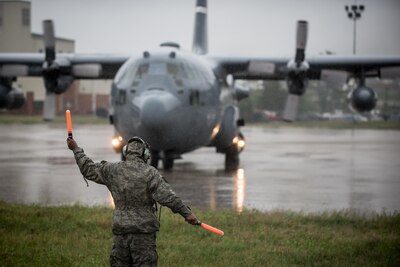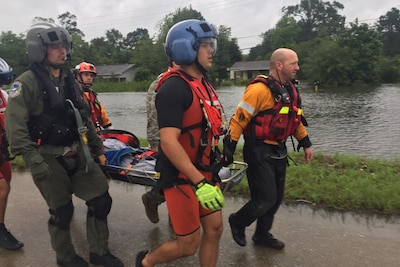By Army Capt. Martha Nigrelle Texas National Guard
ORANGE, Texas, Sept. 2, 2017 — A team of National Guardsmen,
Coast Guardsmen, swift-water rescue technicians and volunteers worked together
here Aug. 30 to rescue and airlift a patient needing special medical attention
from severe flooding caused by Hurricane Harvey to a safe medical facility.
Service members from the Texas National Guard and a
swift-water rescue team from Texas Task Force 1 and the Austin-Travis County
Emergency Medical Service arrived in a severely flooded neighborhood looking to
help anyone in need when, due to special circumstances, they ended up flagging
down a Coast Guard helicopter and evacuating a patient, rescuing him from
danger and potentially saving his life.
"When we first got the call, the information we were
given was that there was a request to evacuate two elderly individuals, one of
whom was paralyzed," said Roger Patterson, Texas Task Force 1 squad
leader. "Our Texas National Guard team assisted us with their high-profile
vehicles to get us as close to the house as possible."
Texas Guardsmen staged their vehicles while Patterson and
his team maneuvered through deep waters, diverse terrain and numerous obstacles
to get to the family in need.
"The water was pretty bad," said Army Pfc. Martin
Davila of the Texas National Guard's 386th Engineer Battalion. "It was
everywhere -- both sides of the roads. Whole houses were under water."
An Improvised Litter
Patterson's team arrived at the house and determined they
would need a litter to safely transport the handicapped gentleman to dry land.
"When we first got there we noticed an inflatable kayak
tied to a street sign," said Matt Paul, swift-water rescue technician and
boat operator for Patterson's Texas Task Force 1 squad. "We decided to use
the kayak as a litter and floatation device, which enabled us to transport him
in the safest and fastest way we could think of."
While Paul and the rest of the members of his team worked to
safely evacuate their patient, Patterson split off to coordinate for medical
transport to ensure that the patient's medical needs could be taken care of
during his evacuation.
Back at the trucks, guardsmen waited for the swift-water
rescue team to return, while volunteers showed up, seemingly out of nowhere,
looking to assist in any way possible.
"One of the really cool things was that when we
evacuated the patient, a volunteer came over with his boat and evacuated his
wife," Paul said, "which enabled us to focus on the well-being of the
patient and his evacuation."
Transport Needed
Patterson coordinated for ambulance transport after
determining that this patient's medical needs required more attention than
might be possible in the military vehicle. "Because of his medical
conditions, we couldn't bring him to any of the shelters open at the
time," he said. "Ambulance transportation was requested but was
significantly delayed due to limited resources and an inundation of
patients."
While Patterson worked on coordinating transport, the
guardsmen and Task Force 1 team worked to protect the man as best possible.
"I was keeping a look out for any emergency vehicles so
I could help get him out of danger as quick as possible so he could get the
medical attention he needed," Davila said. Another man, there looking for
a family member, had two umbrellas in his vehicle and used them to shelter the
patient from the rain. The man needed medical attention for several reasons,
one of which was the inability to regulate his own body temperature.
"We had covered him up with as many blankets as we had
available, but it continued to rain and the temperature was dropping,"
Paul said. "I was concerned with the rain and the temperature; I was
worried he would become hypothermic."
Then a Coast Guard rescue helicopter flew by in what
appeared to be a regular search pattern. Seeing an opportunity for a quicker
medical evacuation, Paul signaled to the helicopter crew that he was asking
them to land.
"They flew around showing us they would land,"
Paul said. "So our Texas Guard partners helped us stop traffic and secure
a landing zone for them, and they were able to land – right in the middle of
[Interstate 10]." Of course, on that day, I-10 traffic was a little
sparse.
"It was kind of exciting," Davilla said. "It
was the first time I have ever been a part of an evacuation by air, but it was
also nerve-wracking, because once we rescued him from the floods we weren't
sure how we would be able to safely evacuate him."
Team Doubled in Size
The team that started out with just Texas soldiers and Task
Force 1 swift-water rescue technicians had now doubled in size, adding
volunteers and the Coast Guard, all with one mission: to get a patient in need
to safety.
"The rescue swimmers approached me and I told them the
situation," Paul said. "They agreed that it was a necessary transport
given his medical conditions. Then the pilot confirmed that they would be able
to evacuate the patient to a safe medical facility."
As the hybrid team transported the patient from his
inflatable kayak-litter to the Coast Guard litter, Patterson told the patient's
wife the plan. "The wife was very thankful," Patterson said.
"She was extremely surprised with the helicopter, but very thankful."
Once the patient was on the helicopter, Coast Guardsmen
transported him and his wife to a medical facility where his condition could be
attended to in safety.
"I'm glad we had all of the support we had,"
Davila said. "It made me really proud to be a Texan to see how everyone
came together to make sure everyone was OK and going somewhere safe."
Teamwork Pays Off
In the aftermath of Hurricane Harvey, first responders say
this type of teamwork is helping to save lives.
This type of teamwork is unique, Paul said. "It's the
first time I have worked with so many different entities, to include the vast
number of volunteers," he added. "To me, a lot of those folks are out
there with their own equipment and on their own time. They are heroes, out
there making sacrifices to help their neighbors out."
First responders may come from different organizations, but
they seem to agree on one thing: working together to help someone in need has
also changed them.
"After the hurricane response is over, this situation
will stick out. We all worked together and were able to do something really
good for this man," Paul said.
"I'm really proud to have been a part of this mission
and help someone in need," Davilla said. "I will continue to volunteer
for any rescue missions or volunteer work needed in the future."







